
'Brilliant, but lazy.'
While many will recall Dr. Octopus’s description of Peter Parker, aka Spiderman, the line has now come to characterise Cesc Fabregas. A world-class midfielder in his prime, the 28-year-old Spaniard is now on the cusp of becoming nothing more than an impact player - a painful fall from grace.
The benefits of having him on the pitch for 90 minutes have slowly but surely been outweighed by his weaknesses. He was bred in the Premier League as it forged him into the modern day attacking midfielder.
Once a teenage prodigy who made a successful move to foreign shores, a Champions League finalist at age 19, a two-time Euro championship winner and a World Cup champion with over a 100 caps for La Furia Roja, he is now struggling to make any sort of impact, struggling to even matter.
The Premier League was once his Colosseum and he was the gladiator who entertained the masses. Now, he has been reduced to a mere sideshow without even the numbers to back any claim to place him alongside Europe’s elite.
How did it come to this?
#1 Fabregas' metamorphosis at Arsenal
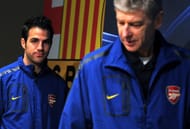
It would be fair to say that although Fabregas did start winning trophies again as soon as he left Arsenal, on a personal level his importance had started to wane. Under Arsene Wenger, he was the keystone to a young team in transition.
Having lost the last of the Invincibles, the team was now structured around Fabregas as Wenger switched formations from a traditional 4-4-2 to a more compact 4-2-3-1.
He was the fulcrum of a squad, the orchestrator in a financially constrained club that threatened to topple the established order from time to time but ultimately failed in the long run. Although they went trophyless, the Gunners’ steadfast philosophy of playing beautiful, attacking football was admired by fans and neutrals alike.
Wenger saw his creativity and quick eye for the perfect pass and virtually stripped him of his defensive duties. He was given the freedom to roam, to find the right spaces; to literally attack without looking back.
Fabregas thrived, grabbing assist after assist, creating chance after chance, winning Team of the Year nominations by the half-dozen.
It wouldn’t be long before Barcelona came back for one they thought was rightfully theirs.
#2 Did Barcelona really need Fabregas?
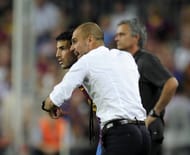
Pep Guardiola would sign his protege after a protracted transfer saga that lasted two seasons. He would give him his old squad number. The man who Barcelona repeatedly stated was not worth more than £30m was suddenly slapped with a £175m release clause after he was signed.
They had just won the Liga and Champions League title the previous season, coming close to a historic second treble. Their midfield had the discipline of Xavi and the wizardry of Andres Iniesta pulling the strings, alongside an indomitable Sergio Busquets feeding a goal-hungry, Ballon d’Or serial winner in Lionel Messi just ahead of them. On the bench was another La Masia star in the making – Thiago Alcantara.
So where was Guardiola going to play Fabregas?
By pushing Iniesta forward, Guardiola managed to accommodate their new big-money signing. But Barcelona’s game suffered. While Fabregas was getting goals and assists, most of them were stat padders against minnows.
The team as a whole suffered against more organised sides when his marauding runs left vacant spaces behind him for opponents to exploit – spaces Iniesta usually had covered.
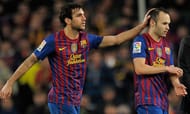
A switch to a 3-4-3 to bring Iniesta back into midfield only complicated matters. Trading positions didn’t work as they seemed to get in each other’s way no matter what Guardiola tried. David Villa’s leg-break also saw them lose an attacking edge.
In a league where even a single loss was a nail in the coffin with respect to title hopes, Barcelona were dropping points with Messi almost single-handedly carrying the team through the season.
Fabregas’s long ridiculed poor showing in the second half of a season saw the team as a whole suffer. His tactical indiscipline saw Barcelona surrender control when it mattered where otherwise they would deprive opponents of both the ball and space.
Tired of repeatedly revamping the system, a frustrated Guardiola would eventually lose the title to Mourinho’s Real Madrid and then take a year-long sabbatical.
#3 New coaches, same problem: Where can Barca play Fabregas?
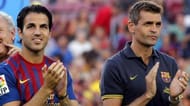
Tito Vilanova tried to change Barcelona’s tiki-taka philosophy, but not entirely. Barcelona’s attack became more direct to get the best out of the both the forward line and Fabregas. They were no longer circulating the ball, waiting to expose a tiny chink in the defence. Instead, Fabregas’s penchant for finding his teammates with high-risk passes as he did at Arsenal was encouraged.
It worked to an extent. Barcelona never surrendered the lead at the top of La Liga, but the Catalan club was no longer the same side that was dominating teams under Guardiola.
Although they won their fourth league title in five years with 100 points, it was mainly individual brilliance that helped them in the league. Messi scored 46 goals that season (a record 91 goals in 2012) and Victor Valdes had one of his best seasons, saving points when they seemed unlikely.
But an injury to the Argentine forward saw Fabregas thrust into the ‘false nine’ role. The logic was sound on paper. It was similar to his role at Arsenal and it worked – but only against the smaller sides. In the Champions League, he struggled.
Only Messi’s heroics in spite of being half-fit would see them move to the semi-final. But even he couldn’t save them from a 7-0 aggregate thrashing at the hands of Bayern Munich.
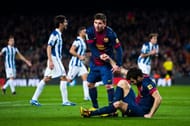
In the league, however, Fabregas continued in that role. But there was no way he was going to replace Messi in that position. In spite of a role more suited to his characteristics, he barely got into double digits, finishing with 11 league goals.
Once again, his second-half-of-the-season syndrome had struck and Barcelona only won the league because of the healthy lead they had by January and Real Madrid’s implosion in Mourinho’s last troubled campaign in Spain.
Tata Martino took over after Vilanova’s untimely and tragic demise and he probably made the biggest blunder of all. He too tried to incorporate both Iniesta and Fabregas on the left again. The result? New signing Neymar was played out of position.
The Brazilian was shunted out to the right to get the best of Fabregas. Ultimately, Neymar’s pace and skill protected him with “acclimatising to La Liga” one of the excuses bandied about. But it was Martino’s insistence of playing Fabregas on the left with Iniesta when it should clearly have been Iniesta behind Neymar.
#4 The end of a boyhood dream
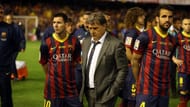
Fabregas’s despairing performances in the latter half of the season would continue and his minutes on the pitch reduced. Substitutions were made sooner to get him off when, ideally, he shouldn’t have started at all.
A number of players suffered while Fabregas made the starting XI. Thiago Alcantara, a rightful heir to Xavi’s throne, had already left the previous summer with Pep Guardiola convincing him to join him at Bayern Munich. The hard-working Alexis Sanchez was benched and so was Pedro – just to make room for Fabregas.
The last campaign would be his worst season at his boyhood club. Barcelona would end trophyless and in Fabregas’s third and final season a third manager would leave Barcelona. Luis Enrique was appointed to take over and he wanted nothing to do with Fabregas, as Ivan Rakitic was signed and offered Guardiola’s iconic shirt.
There was a glimmer of hope when Arsenal came calling in the summer of 2014, but the Gunners were only interested in Alexis.
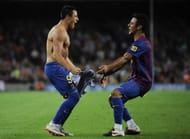
Stats will show Fabregas scored 42 goals in three seasons at the Camp Nou. Not bad for a midfielder. But he was anything but an ordinary midfielder at Barcelona and, of those 42, only about a third of those goals were ones that really mattered.
Having evolved in the Premier League where space and time are available in plenty to those who relish it, Fabregas found out the hard way that both are a luxury in the more tactically astute La Liga. The hell-for-leather approach may work in England but, in Spain, the compactness and discipline of a side always decides the final outcome.
#5 Redemption in the EPL before familiar failings resurface
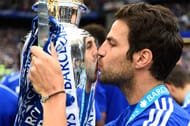
Ultimately, Fabregas would return to London, only to sign for Chelsea. In his words, he had ‘unfinished business in the Premier League’. Arsenal fans berated Wenger for not triggering the buy-back clause. But they didn’t need him having already signed Mesut Ozil.
Fabregas’s first season with Chelsea was all about redemption. Spurned by his first love and rejected by his second, Fabregas set out to prove a point. This time, the supporting cast in England was more adept at winning trophies with Mourinho having his way and also signing Diego Costa.
Costa and Fabregas dovetailed splendidly and ripped teams apart in the early stages as Mourinho’s Blues went on an unbeaten run till December. Back in the comfy environs of the EPL, Fabregas was at his splendid best – recording assists in the quest to break Thierry Henry’s record of 20 assists in a season. He came close, finishing with 18 – tying club legend Frank Lampard.
The title was sewn up by the start of May as Manchester City’s challenge faded away. Mourinho had won again in his second season thanks to a total team effort from front to back. Eden Hazard took home the PFA Player of the Year while he was also selected in the Team of the Year alongside five of his teammates.
However, Fabregas did not make that team. Why? Again, he was almost invisible post-January. 13 of those 18 assists were made before the new year. He seemed to drift in and out of games as opponents found ways to contain him by isolating him and blocking the passing channels in front of him.
#6 Beginning of the end?
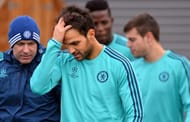
The 2015/16 season would probably be the worst of Fabregas’s career. With just one goal and three assists in all competitions, he has been involved in a goal just once every 388 minutes. At one stage, he was misplacing more passes than anyone else in Europe.
Cesc Fàbregas: Only 2 outfield players have misplaced more passes in Europe’s top 5 leagues this season than Fàbregas (76) #cfc
— WhoScored.com (@WhoScored) September 22, 2015
As Chelsea’s season faltered, so did Fabregas. When played in a deep midfield role, he was of absolutely no help in covering an ageing defence. Nemanja Matic’s lack of form added to Mourinho’s misery. Fabregas was being beaten time and again as the game simply passed him by.
It is almost as if his heart isn’t in it anymore. The player who played to the masses is suddenly a pariah in their eyes – a reason for their collective failure. While there is a plethora of explanations for Chelsea’s abject displays this season, in the heart of it all is Fabregas – unable to make a telling impact both on and off the ball.
When Jose Mourinho benched him for the crucial Champions League encounter against Porto and played Ramires beside Matic, Chelsea suddenly looked a different animal. One could argue that Fabregas could have played as a no.10 but Oscar had put in a decent shift in that position too. The Brazilians ran after almost every ball, pressurising the midfielders and forcing errors.
Mourinho got his desired result and Chelsea topped the group. Fabregas wasn’t even used as a substitute.
The Spaniard still has the necessary quality to succeed in the EPL. But he is now coming close to becoming just another squad player under Mourinho. He is now facing the same questions that were asked of his compatriot Juan Mata during his stint at Chelsea.
Once upon a time, the game revolved around Fabregas. Time seemed to stand still when the ball was at his feet as he quickly picked out his teammates with a vision that was unparalleled for a player his age. Now, it is Fabregas who has stood still – as time, as always, refuses to wait.
